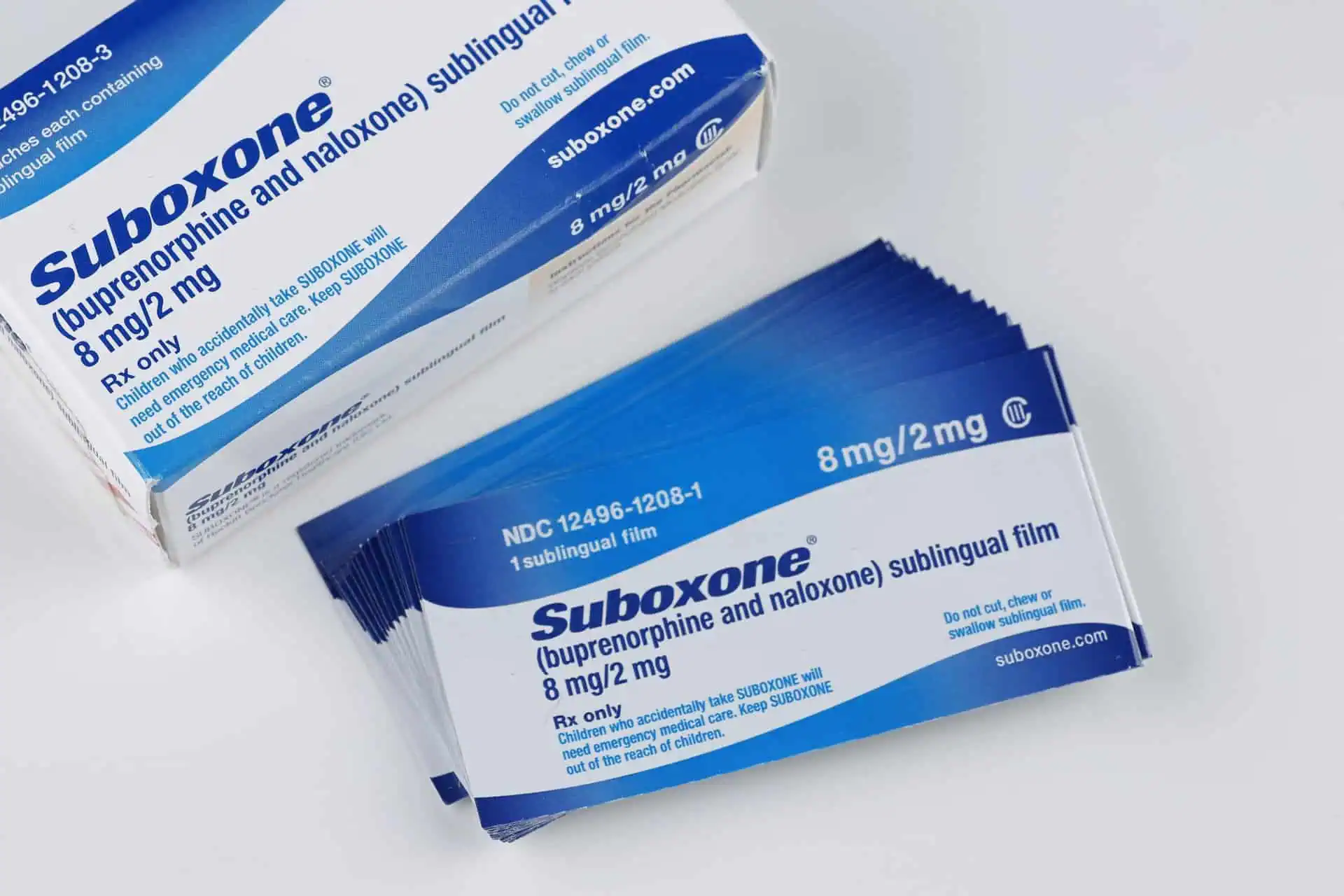Can I Still Join The Suboxone Tooth Decay MDL?
- Last Updated: June 12th, 2025

Attorney Jessica Paluch-Hoerman, founder of TruLaw, has over 28 years of experience as a personal injury and mass tort attorney, and previously worked as an international tax attorney at Deloitte. Jessie collaborates with attorneys nationwide — enabling her to share reliable, up-to-date legal information with our readers.
Legally Reviewed
This article has been written and reviewed for legal accuracy and clarity by the team of writers and legal experts at TruLaw and is as accurate as possible. This content should not be taken as legal advice from an attorney. If you would like to learn more about our owner and experienced injury lawyer, Jessie Paluch, you can do so here.
Fact-Checked
TruLaw does everything possible to make sure the information in this article is up to date and accurate. If you need specific legal advice about your case, contact us by using the chat on the bottom of this page. This article should not be taken as advice from an attorney.
Key takeaways:
- Suboxone, a medication commonly used to treat opioid dependence, has been linked to significant dental health concerns.
- Recent suboxone tooth decay claims have pointed toward a potential risk of tooth decay and other dental problems.
- Patients began to report severe dental issues, leading to the formation of an MDL to address the growing number of suboxone tooth decay cases.
Overview of the The Suboxone Tooth Decay MDL
On this page, we’ll provide an overview of the Suboxone Tooth Decay MDL, responses from pharmaceutical companies in the Suboxone Tooth Decay MDL, whether or not you can still join the Suboxone Tooth Decay MDL, and much more.
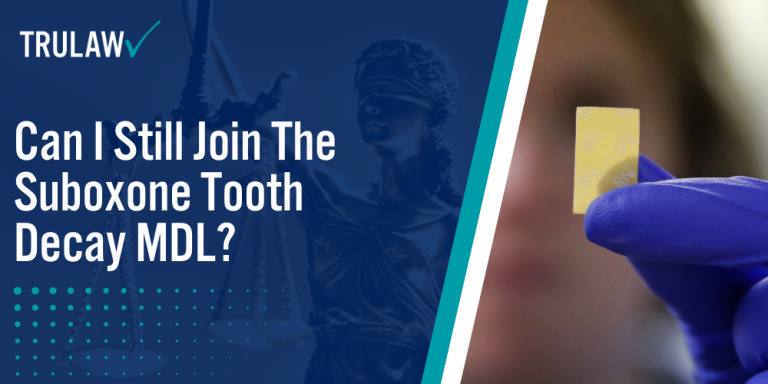
Intro to the Suboxone Tooth Decay MDL
To determine your eligibility for the MDL, consider the following:
- Review the FDA’s communication regarding Suboxone and dental problems.
- Consider the individual testimonies of dental erosion associated with Suboxone.
- Examine the procedural updates within the MDL No. 3092 Transfer Order.
- Understand the broad scope of litigation, including pending actions and centralized cases.
If you or a loved one has experienced severe tooth decay, deteriorating dental health, or dental injuries after taking Suboxone, you may be entitled to pursue compensation for your damages.
Contact TruLaw using the chat on this page for a free and instant case evaluation to find out if you qualify to join others filing in the Suboxone Tooth Decay MDL.
Table of Contents
Understanding the Suboxone Tooth Decay MDL
On this page, we’ll discuss an overview of the Suboxone tooth decay lawsuits, the implications for those taking opioid addiction medication, aspects related to dental health, issues concerning prescription Suboxone film, and considerations regarding Suboxone sublingual films, and much more.
Can I Still Join The Suboxone Tooth Decay MDL?
The Suboxone Tooth Decay MDL specifically addresses allegations that Suboxone sublingual films — used as a treatment for opioid addiction — may cause significant dental health issues, such as tooth decay.
Individuals who have been prescribed this medication and subsequently experienced dental problems have commenced legal actions, which have been consolidated into a Multidistrict Litigation (MDL).
This MDL centralizes pretrial proceedings with the aim of dealing with numerous cases that share common factual questions, thus providing efficiency and consistency in the rulings.
As with any MDL, people often wonder if they can join the suboxone lawsuits even after the litigation has commenced.
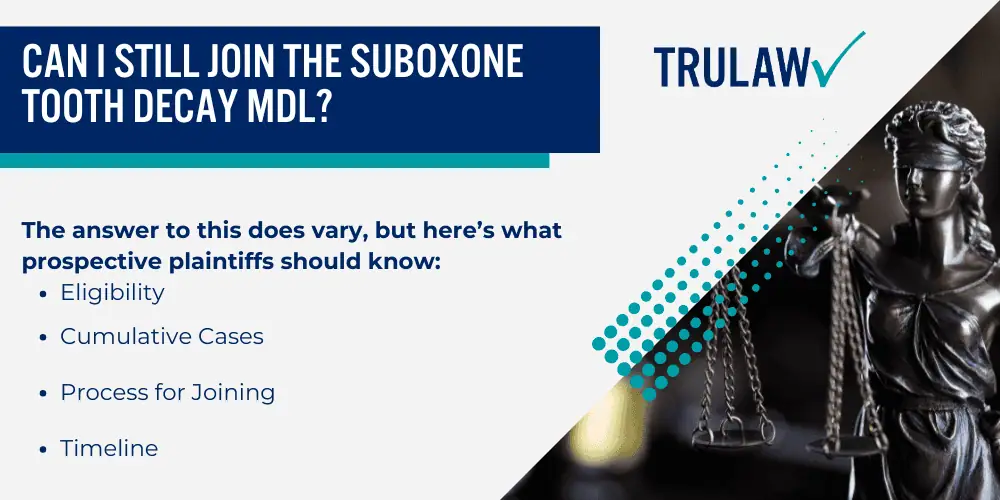
The answer to this does vary, but here’s what prospective plaintiffs should know:
- Eligibility: Affected users of prescription Suboxone film might be eligible to join the MDL, depending on when they experienced the dental issues and the specifics of their medical history.
- Cumulative Cases: As of now, numerous cases have been incorporated into this MDL across multiple districts, showing the breadth of the issue.
- Process for Joining: Generally, new plaintiffs would file a claim in their jurisdiction, which might then be transferred to the MDL.
- Timeline: The eligibility timeframe for joining an MDL is typically determined by deadlines, referred to as statutes of limitations.
Suboxone tooth decay lawsuits continue to develop, and plaintiffs seek recovery for the harm they’ve suffered both physically and financially due to dental problems.
Suboxone teeth lawsuits shine a light on the potential side effects of opioid addiction medication and stress the importance of informed consent and awareness of medication risks.
Staying informed of the latest developments in the Suboxone MDL is essential for those affected and considering joining the litigation.
As the situation evolves, additional information becomes available, offering further guidance for prospective plaintiffs.
Clinical Evidence of Suboxone-Related Dental Issues
Recent studies and patient reports have highlighted a concerning link between the use of Suboxone, particularly in strip form, and the development of severe dental issues.
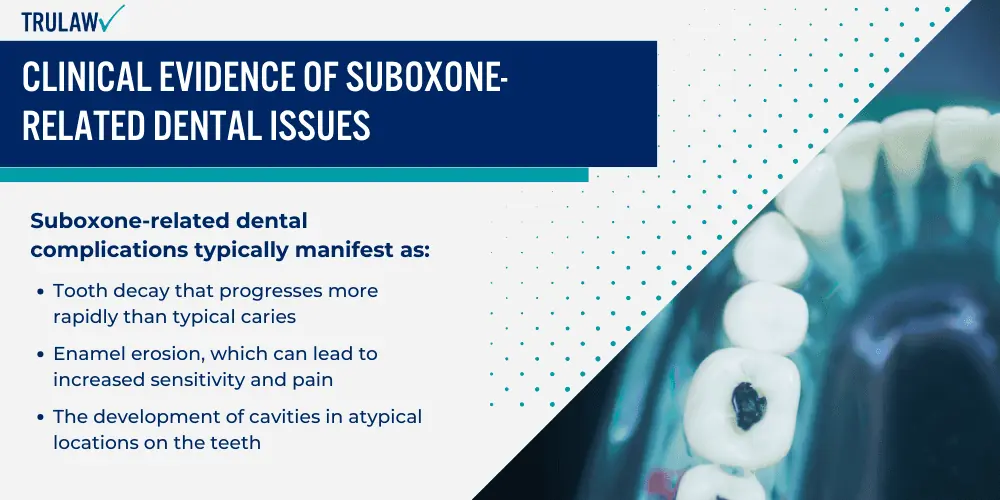
These problems range from enamel erosion to tooth decay.
Tooth Decay and Enamel Erosion Linked to Suboxone Strips
The formulation of Suboxone strips, designed to dissolve sublingually, has been associated with an increase in dental caries and the erosion of tooth enamel.
Research indicates that the way Suboxone is administered may erode tooth enamel, leading to significant dental injuries.
Suboxone-related dental complications typically manifest as:
- Tooth decay that progresses more rapidly than typical caries
- Enamel erosion, which can lead to increased sensitivity and pain
- The development of cavities in atypical locations on the teeth
- An overall weakening of the tooth structure, making them more susceptible to breakage and loss
The FDA has issued warnings about the potential for dental problems associated with medications like Suboxone that dissolve in the mouth due to the oral health issues reported in patients with no prior history of dental problems.
Concerns Growing From Suboxone-Related Dental Injury Reports
As more patients use Suboxone for opioid dependency treatment, dental practitioners are noting an uptick in dental injuries related to its use.
It is essential for patients and healthcare providers to be aware of the potential dental side effects.
Reports of Suboxone-related dental issues have highlighted:
- An unexpected rate of severe dental decay among patients using Suboxone strips
- Other dental injuries that include abscesses and advanced tooth decay requiring extractions
- Cases where previously healthy teeth suddenly exhibit rapid tooth erosion and decay
- Descriptions of the mouth’s environment changing, making it more conducive to bacteria that cause dental caries
The case series published by the National Institutes of Health underscores the necessity for further investigation into the relationship between Suboxone use and detrimental effects on oral health.
The Current Status of the Suboxone Dental Litigation in Ohio
The state of Ohio has been active in addressing the alleged link between Suboxone usage and dental issues.
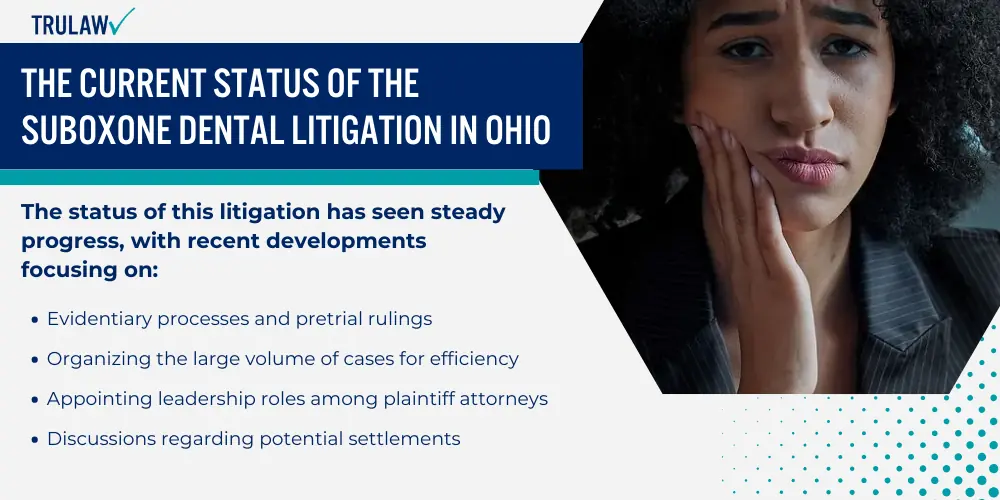
Recent developments highlight the legal processes Midwest residents face when dealing with Suboxone tooth decay litigation.
Multidistrict Litigation and Suboxone Class Action Lawsuit
Multidistrict litigation (MDL) has been established to address claims related to Suboxone, a medication used to treat opioid addiction that has been associated with oral health problems, such as tooth decay.
The MDL 3092 has centralized numerous federal suboxone lawsuits alleging that the Suboxone film causes dental erosion and decay.
Suboxone class action lawsuits have also emerged, with plaintiffs seeking compensation for damages due to these dental conditions.
In Ohio, the status of this litigation has seen steady progress, with recent developments focusing on:
- Evidentiary processes and pretrial rulings
- Organizing the large volume of cases for efficiency
- Appointing leadership roles among plaintiff attorneys
- Discussions regarding potential settlements
The MDL has been transferred to the Northern District of Ohio to streamline the pretrial procedures for all related cases.
Strategic Role of Attorneys in Suboxone Cases: TruLaw
Suboxone tooth decay lawyers specializing in pharmaceutical litigation, like those from TruLaw, play a pivotal role in shaping the outcome of the Suboxone tooth decay litigation.
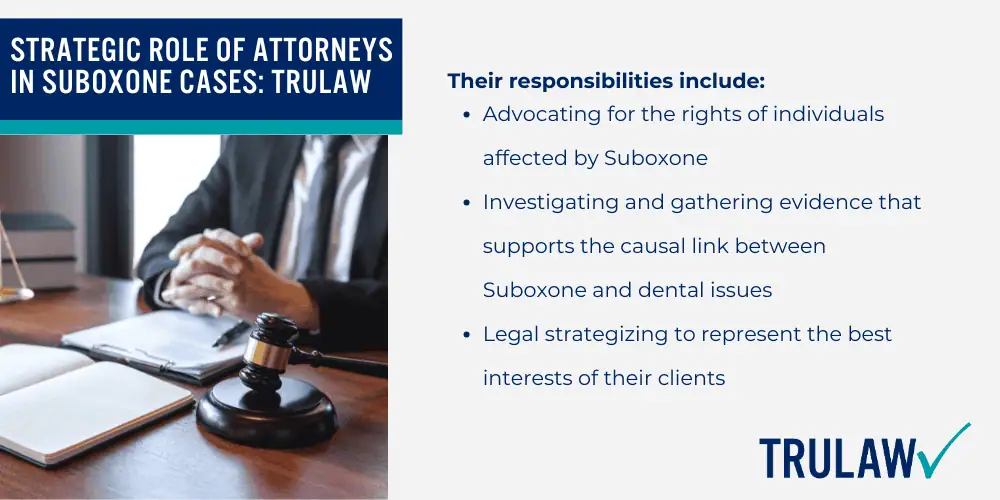
Their responsibilities include:
- Advocating for the rights of individuals affected by Suboxone
- Investigating and gathering evidence that supports the causal link between Suboxone and dental issues
- Legal strategizing to represent the best interests of their clients
Suboxone Lawyers work to ensure that those affected by the potentially damaging side effects of Suboxone receive fair representation in the justice system.
Personal Experiences and Stories of Suboxone Dental Health
Patients who have been prescribed Suboxone, a medication typically used for opioid addiction treatment, have reported a range of oral health problems.
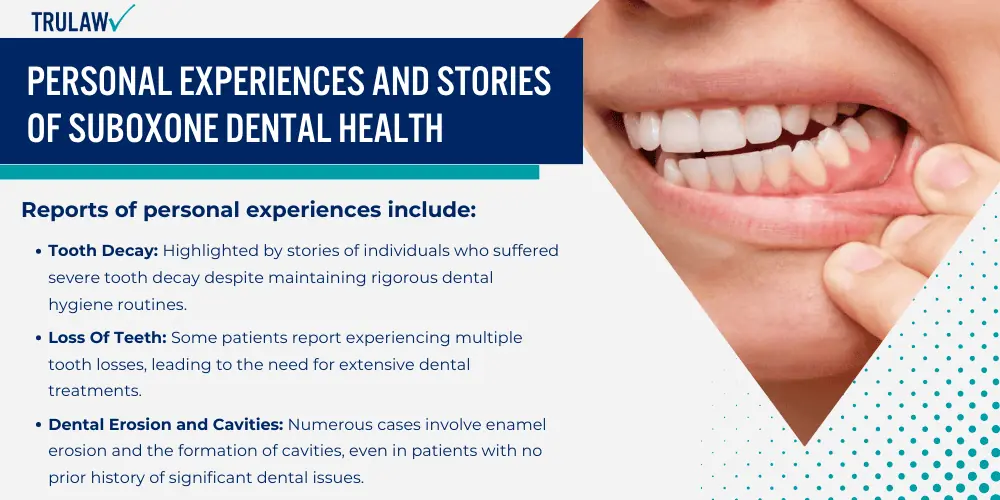
These personal accounts often emphasize the severity of dental conditions and the consequent impact on lifestyle and health.
Accounts of Severe Dental Conditions
Personal narratives often shed light on the extent of dental damage attributed to the use of Suboxone.
Reports include:
- Tooth Decay: Highlighted by stories of individuals who suffered severe tooth decay despite maintaining rigorous dental hygiene routines.
- Loss Of Teeth: Some patients report experiencing multiple tooth losses, leading to the need for extensive dental treatments.
- Dental Erosion and Cavities: Numerous cases involve enamel erosion and the formation of cavities, even in patients with no prior history of significant dental issues.
- Oral Infections: A side effect of Suboxone is that it reduces saliva production and has been linked to an increased risk of dental abscesses and infections.
Impact of Dental Issues on Lifestyle and Health
The impact of these dental problems goes beyond mere discomfort.
Consider the following ways dental problems can negatively impact your life:
- Nutrition: Difficulty chewing can limit dietary choices, potentially complicating nutritional intake and overall health.
- Speech: Tooth loss and oral pain may alter speech, affecting communication and social interactions.
- Mental well-being: Chronic dental pain and visible dental injuries can contribute to emotional distress and decreased self-esteem.
- Financial Strain: The cost of repairing severe dental injuries can be substantial, creating an added financial burden for individuals and families.
Examining Suboxone Prescription Practices
When prescribing Suboxone for opioid addiction treatment, healthcare professionals must balance efficacy with potential risks, including adverse dental outcomes.
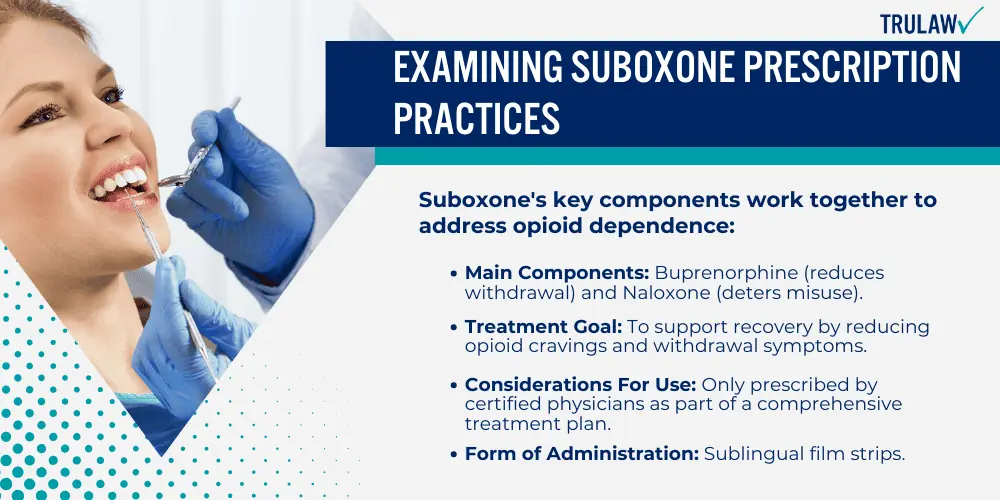
Understanding Suboxone as an Opioid Addiction Treatment
Suboxone combines buprenorphine, a partial opioid agonist, and naloxone, an opioid antagonist.
It’s administered to mitigate withdrawal symptoms and cravings in individuals struggling with opioid dependence.
Typically prescribed in two forms, it comes as a prescription suboxone film that dissolves under the tongue and as a suboxone tablet.
Suboxone’s key components work together to address opioid dependence:
- Main Components: Buprenorphine (reduces withdrawal) and Naloxone (deters misuse).
- Form of Administration: Sublingual films or tablets.
- Treatment Goal: To support recovery by reducing opioid cravings and withdrawal symptoms.
- Considerations For Use: Only prescribed by certified physicians as part of a comprehensive treatment plan.
Physician Responsibility in Prescribing Suboxone
Physicians prescribing Suboxone must be certified, ensuring they have adequate knowledge of opioid addiction and are aware of both the benefits and risks associated with its use.
Key responsibilities include:
- Conducting thorough patient evaluations to identify suitability for Suboxone treatment.
- Discussing potential side effects, including dental health risks.
- Providing guidance on the proper administration of physician-prescribed suboxone film or tablets.
- Ensuring regular follow-ups to monitor treatment effectiveness and patient adherence.
Monitoring Adverse Dental Outcomes from Suboxone
Research has highlighted a link between the long-term use of Suboxone, specifically the sublingual films, and dental issues such as tooth decay and erosion.
It’s imperative that providers monitor patients for these adverse outcomes.
Monitoring strategies:
- Regular dental check-ups as part of the treatment regimen.
- Patient education on oral hygiene while using Suboxone.
- Prompt referral to dental specialists if adverse effects are observed.
- Documentation of any dental side effects to contribute to ongoing research.
When addressing opioid addiction, it is crucial to handle the prescription of Suboxone with utmost care.
This involves recognizing its significance in recovery while also managing potential dental risks.
Responses from Pharmaceutical Companies
In the context of the Multi-District Litigation (MDL) concerning Suboxone tooth decay, drug manufacturers have issued statements and faced analysis surrounding product liability issues.
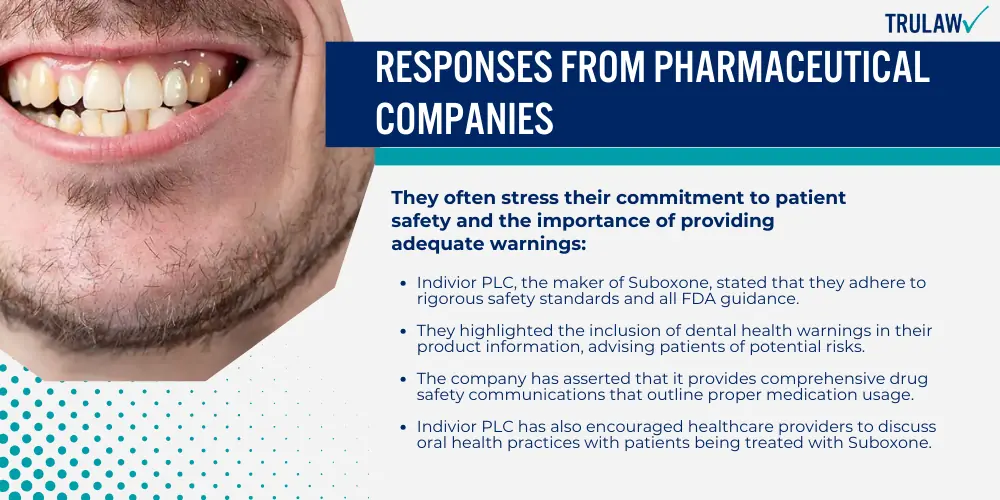
Statements from Suboxone Drug Manufacturers
Suboxone drug manufacturers have publicly addressed the tooth decay claims linked to their products.
They often stress their commitment to patient safety and the importance of providing adequate warnings:
- Indivior PLC, the maker of Suboxone, stated they adhere to rigorous safety standards and all FDA guidance.
- They highlighted the inclusion of dental health warnings in their product information, advising patients of potential risks.
- The company has asserted that it provides comprehensive drug safety communications that outline proper medication usage.
- Indivior PLC has also encouraged healthcare providers to discuss oral health practices with patients being treated with Suboxone.
Analysis of Product Liability Issues
Recent lawsuits allege that Suboxone film, a medication used to treat opioid dependence, causes serious dental problems due to a lack of sufficient warnings.
Plaintiffs argue manufacturers failed to adequately inform patients and doctors about the risks.
Legal experts and analysts weighing in on the product liability lawsuits against Suboxone manufacturers have pointed out several key areas of concern:
- Manufacturers’ responsibility to provide clear warnings and instructions to minimize risks.
- Evaluation of patient reports and clinical data concerning oral health impacts.
- Legal precedents are set in similar pharmaceutical cases.
- The degree of harm suffered by patients due to alleged inadequate product labeling and warnings.
Exploring Treatment Options for Opioid Use Disorder
When addressing opioid addiction, a nuanced approach is necessary to consider both the efficacy of treatments and their potential health implications.
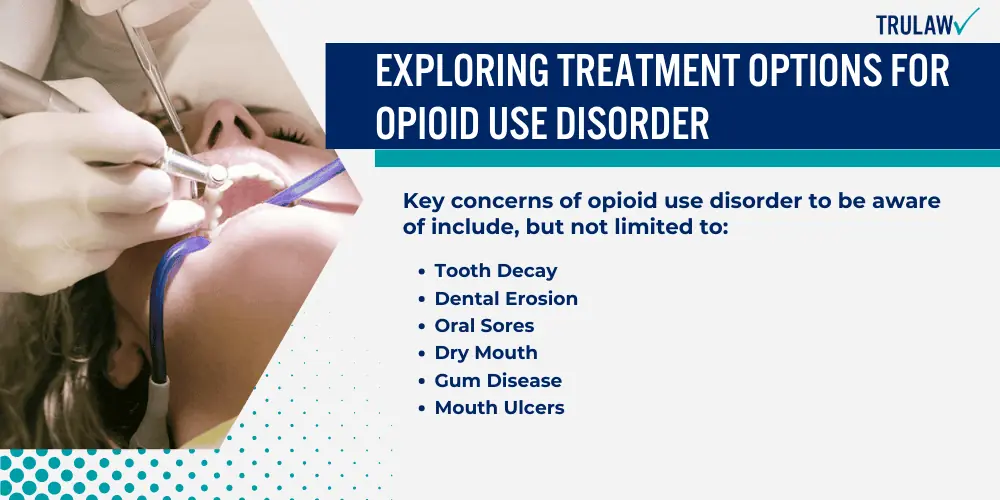
Potential Dental Health Risks of Suboxone Sublingual Strips
Sublingual strips used to treat opioid addiction, such as Suboxone (a combination of sublingual buprenorphine and naloxone), have been associated with dental health issues.
The FDA warns of the risk that these sublingual medications can cause dental problems.
Some key concerns to be aware of are:
- Tooth decay
- Dental erosion
- Oral sores
- Dry mouth
- Gum disease
- Mouth ulcers
Comparing Medications for Opioid Addiction
Various medications are available to treat opioid addiction.
These include:
- Methadone: This long-acting opioid agonist is dispensed daily in a clinic setting.
- Naltrexone: An opioid antagonist, this is available in oral form or as a monthly injection (Vivitrol).
- Sublingual buprenorphine: Often preferred for its ease of use and lower risk of misuse.
- Sublingual buprenorphine-naloxone: This combination helps reduce the risk of misuse by including naloxone, which blocks opioid effects when injected.
Assessing the Risk of Dental Complications
Sublingual buprenorphine-naloxone can dry out the mouth, reducing saliva flow and increasing the risk of tooth decay and gum disease.
Therefore, healthcare providers assess several factors to determine a patient’s risk of dental complications.
When evaluating the risk of dental complications, healthcare providers consider the following:
- Duration and dosage of sublingual buprenorphine-naloxone exposure
- The patient’s oral hygiene practices
- Access to regular dental care
- Underlying health conditions that may exacerbate dental problems
It’s essential for patients undergoing treatment for opioid use disorder to receive regular dental check-ups to monitor and address any emerging oral health issues.
Preventative Measures and Dental Care Suggestions
Maintaining optimal dental health is essential for patients on Suboxone to prevent issues such as tooth decay and oral infections.
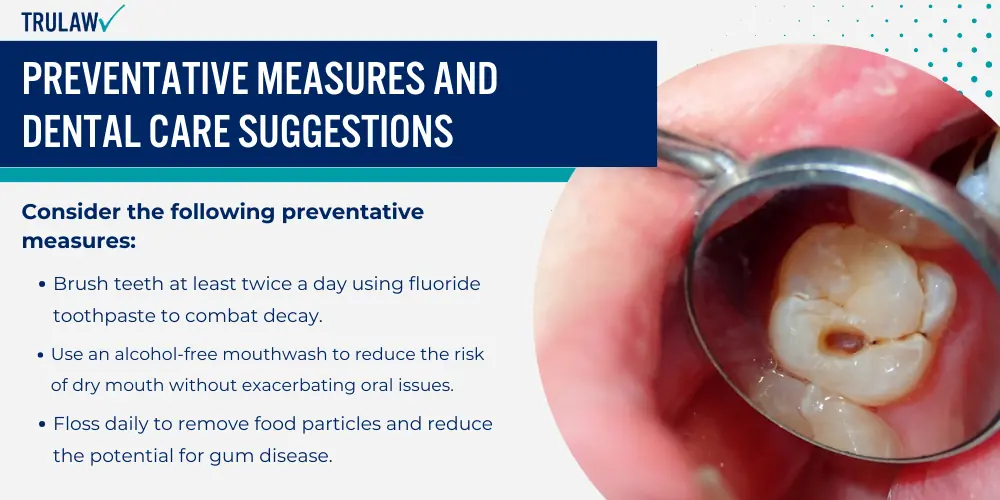
This section offers concrete steps and collaborative strategies to safeguard oral health.
Best Practices for Oral Hygiene with Suboxone
Proper oral hygiene can significantly reduce the risk of dental problems.
Below are four essential practices:
- Brush teeth at least twice a day using fluoride toothpaste to combat decay.
- Use an alcohol-free mouthwash to reduce the risk of dry mouth without exacerbating oral issues.
- Floss daily to remove food particles and reduce the potential for gum disease.
- Regularly replace toothbrushes every three to four months to maintain efficacy.
Collaborative Care Approach for Patients
A team-based approach can enhance the delivery of preventative care.
Here are key collaborative measures:
- Schedule regular dental check-ups to monitor and manage oral health proactively.
- Discuss the potential side effects of Suboxone with a dentist to tailor a personalized oral care plan.
- If tooth extractions or other dental surgeries are necessary, ensure clear communication between healthcare providers.
- Employ a diet low in sugar and consult with a nutritionist to reduce the likelihood of cavities and oral infections.
By incorporating these best practices into daily routines and adopting a collaborative care model, patients on Suboxone can better protect their oral health and prevent serious dental issues.
Understanding Compensation Claims in Dental Health Cases
When patients face dental issues potentially connected to Suboxone use, they may consider seeking compensation through a legal claim.
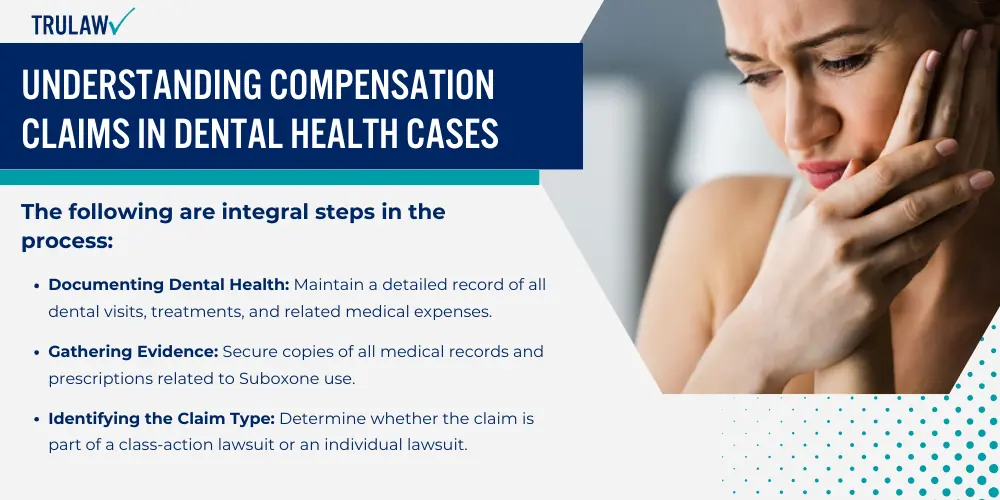
This section outlines how individuals can navigate the Suboxone claims process and underlines the importance of legal consultation.
How to Navigate the Suboxone Claims Process Effectively
Navigating the Suboxone claims process demands a structured approach to ensure all the requisite steps are meticulously followed.
The following are integral steps in the process:
- Documenting Dental Health: Maintain a detailed record of all dental visits, treatments, and related medical expenses.
- Gathering Evidence: Secure copies of all medical records and prescriptions related to Suboxone use.
- Identifying the Claim Type: Determine whether the claim is part of a class-action lawsuit or an individual lawsuit.
- Submitting Claims: Complete all necessary forms for the Suboxone dental lawsuit and adhere to the specified deadlines.
Seeking Legal Advice for Suboxone Dental Complications
Securing professional legal advice is essential for addressing Suboxone-related dental problems.
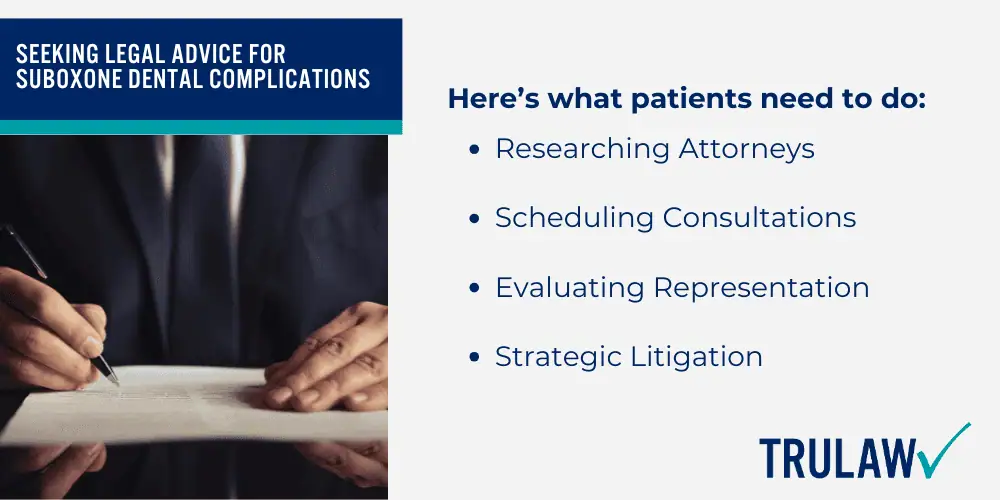
Here’s what patients need to do:
- Researching Attorneys: Look for law firms with experience in handling pharmaceutical lawsuits, especially those related to Suboxone.
- Scheduling Consultations: Take advantage of free consultation offers to discuss potential claims and understand the legal avenues available.
- Evaluating Representation: Choose an attorney who effectively communicates the likelihood of a Suboxone settlement and what it may entail.
- Strategic Litigation: Follow the legal strategy devised by your attorney to pursue the compensation claim.
The Opioid Epidemic's Impact on Dental Wellness
The opioid epidemic has cast a shadow over numerous aspects of public health, including dental wellness, revealing a troubling connection between opioid dependence and various dental problems.
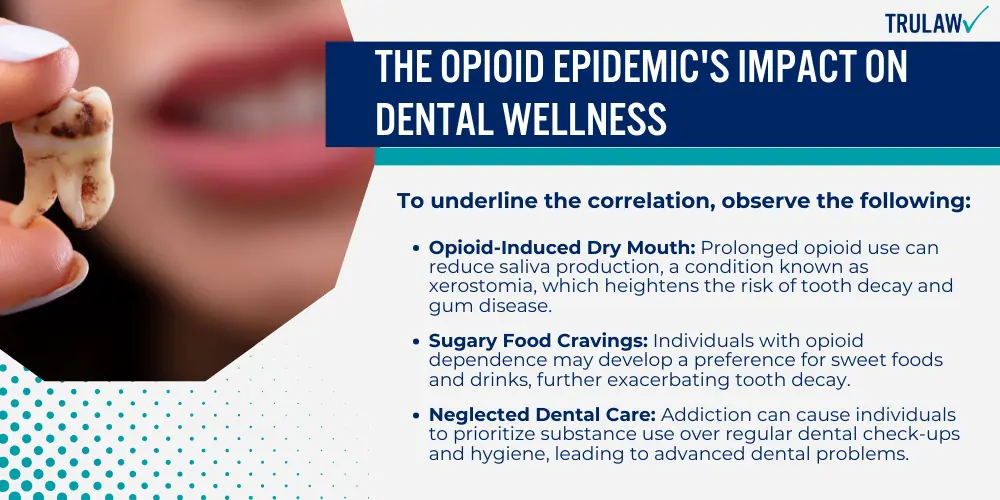
This section explores the detrimental impact of opioid misuse on oral health.
Correlation Between Opioid Addiction and Dental Problems
Opioid addiction often leads to neglect of personal hygiene routines, including oral care, which can culminate in significant dental issues.
The commonly prescribed medication for opioid dependence, such as buprenorphine (found in medications like Suboxone), has been linked to oral health side effects.
To underline the correlation, observe the following:
- Opioid-Induced Dry Mouth: Prolonged opioid use can reduce saliva production, a condition known as xerostomia, which heightens the risk of tooth decay and gum disease.
- Sugary Food Cravings: Individuals with opioid dependence may develop a preference for sweet foods and drinks, further exacerbating tooth decay.
- Neglected Dental Care: Addiction can cause individuals to prioritize substance use over regular dental check-ups and hygiene, leading to advanced dental problems.
- Medication Side EffectsSome treatments for opioid addiction, including those that involve dissolving medication in the mouth, have been linked to tooth decay, gum disease, and even tooth loss.
The enhancement of dental wellness in the midst of the opioid crisis necessitates a comprehensive approach that addresses the underlying causes of addiction and the resultant health implications.
A dual strategy encompassing treatment interventions and educational initiatives emphasizing the significance of oral health stands to effectively alleviate these formidable challenges.
Suboxone Lawsuit Frequently Asked Questions
-
To join the Suboxone tooth decay lawsuit, individuals must have used Suboxone and subsequently suffered from dental issues, such as tooth decay or tooth loss.
Documentation of medical treatment for these dental issues may be required to establish a connection to Suboxone usage.
-
The potential compensation for affected individuals may cover dental treatment costs, pain and suffering, and other damages resulting from Suboxone-related tooth decay.
The exact compensation will vary based on individual circumstances and the lawsuit’s outcome.
-
To sign up for the lawsuit, interested parties should contact a qualified attorney specializing in pharmaceutical litigation.
They will help to determine eligibility and guide through the process of joining the multidistrict litigation (MDL).
-
Each lawsuit has specific deadlines, known as statutes of limitations, which vary by state.
It’s crucial to consult an attorney promptly to avoid missing these deadlines and ensure participation in the legal action.
-
If a settlement is reached, distribution to claimants will follow a plan approved by the court.
Each claimant’s share will depend on the extent of their dental damage and other individual factors considered during the litigation process.
-
Recent legal developments in the Suboxone case include ongoing proceedings in the multidistrict litigation.
Individuals should regularly check announcements from the Federal Drug Administration or court documents pertaining to the case for the latest updates.

Managing Attorney & Owner
With over 25 years of legal experience, Jessica Paluch-Hoerman is an Illinois lawyer, a CPA, and a mother of three. She spent the first decade of her career working as an international tax attorney at Deloitte.
In 2009, Jessie co-founded her own law firm with her husband – which has scaled to over 30 employees since its conception.
In 2016, Jessie founded TruLaw, which allows her to collaborate with attorneys and legal experts across the United States on a daily basis. This hypervaluable network of experts is what enables her to share the most reliable, accurate, and up-to-date legal information with our readers!
Additional Suboxone Lawsuit resources on our website:
Here, at TruLaw, we’re committed to helping victims get the justice they deserve.
Alongside our partner law firms, we have successfully collected over $3 Billion in verdicts and settlements on behalf of injured individuals.
Would you like our help?
At TruLaw, we fiercely combat corporations that endanger individuals’ well-being. If you’ve suffered injuries and believe these well-funded entities should be held accountable, we’re here for you.
With TruLaw, you gain access to successful and seasoned lawyers who maximize your chances of success. Our lawyers invest in you—they do not receive a dime until your lawsuit reaches a successful resolution!
AFFF Lawsuit claims are being filed against manufacturers of aqueous film-forming foam (AFFF), commonly used in firefighting.
Claims allege that companies such as 3M, DuPont, and Tyco Fire Products failed to adequately warn users about the potential dangers of AFFF exposure — including increased risks of various cancers and diseases.
Depo Provera Lawsuit claims are being filed by individuals who allege they developed meningioma (a type of brain tumor) after receiving Depo-Provera birth control injections.
A 2024 study found that women using Depo-Provera for at least 1 year are five times more likely to develop meningioma brain tumors compared to those not using the drug.
Suboxone Tooth Decay Lawsuit claims are being filed against Indivior, the manufacturer of Suboxone, a medication used to treat opioid addiction.
Claims allege that Indivior failed to adequately warn users about the potential dangers of severe tooth decay and dental injuries associated with Suboxone’s sublingual film version.
Social Media Harm Lawsuits are being filed against social media companies for allegedly causing mental health issues in children and teens.
Claims allege that companies like Meta, Google, ByteDance, and Snap designed addictive platforms that led to anxiety, depression, and other mental health issues without adequately warning users or parents.
Transvaginal Mesh Lawsuits are being filed against manufacturers of transvaginal mesh products used to treat pelvic organ prolapse (POP) and stress urinary incontinence (SUI).
Claims allege that companies like Ethicon, C.R. Bard, and Boston Scientific failed to adequately warn about potential dangers — including erosion, pain, and infection.
Bair Hugger Warming Blanket Lawsuits involve claims against 3M — alleging their surgical warming blankets caused severe infections and complications (particularly in hip and knee replacement surgeries).
Plaintiffs claim 3M failed to warn about potential risks — despite knowing about increased risk of deep joint infections since 2011.
Baby Formula NEC Lawsuit claims are being filed against manufacturers of cow’s milk-based baby formula products.
Claims allege that companies like Abbott Laboratories (Similac) and Mead Johnson & Company (Enfamil) failed to warn about the increased risk of necrotizing enterocolitis (NEC) in premature infants.
Here, at TruLaw, we’re committed to helping victims get the justice they deserve.
Alongside our partner law firms, we have successfully collected over $3 Billion in verdicts and settlements on behalf of injured individuals.
Would you like our help?
